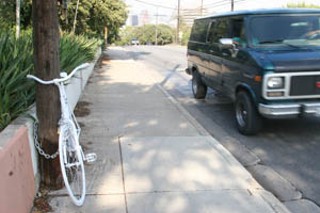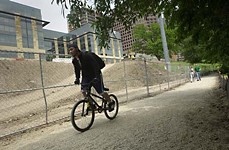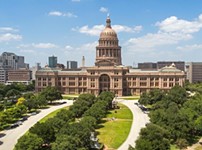Riding at Risk
Austin's streets still a hazard for two-wheeled transportation
By Daniel Mottola, Fri., Nov. 10, 2006

On May 21 at 4:27am, a man phoned 911 and told the operator (as recounted in the police affidavit for his arrest) that he thought a body had been "thrown" at his car as he was driving home. The caller, 38-year-old Rudy Saenz, hadn't unsuspectingly wandered into a mafia-style slaying that early morning. In fact, Saenz had hit, and run over, a bicyclist from behind, and then had driven away from the scene.
Saenz was described as sounding "very intoxicated," his speech slow and slurred. Later, he told police he was returning home from the bar Oilcan Harry's on West Fourth Street. The body he hit was that of 29-year-old Austin green-building contractor Casey "Wink" Miller, who was pedaling home in the right-hand lane of South First Street's 1100 block, less than two blocks from his home. According to Miller, the initial impact catapulted him into the air, and he came crashing down onto the car's windshield before landing on the street. There, he recalls, the car ran over his leg – shattering it in three places – before speeding off. He remembers hysterically wondering if his dangling foot would be amputated.
Miller said he had been Downtown eating pizza and drinking beer, but waited more than an hour before heading home. He was later told by medics that his own blood alcohol level was above the legal limit for driving. (Although it does not appear that Miller's condition played any role in the accident, an intoxicated bicyclist can be arrested and jailed, and cited for misdemeanor public intoxication.)
Six months and more than $45,000 in medical bills later, Miller is out of his wheelchair and walking with crutches, working more, but unsure whether he'll regain full use of his foot. Through one of Seton Hospital's financial assistance programs, $30,000 of his hospital bills have been paid. But the $25,000 liability settlement he received from Saenz's auto insurance has barely offset the unpaid bills that piled up while he was out of work, on top of $100-per-week medication expenses, leaving him currently $15,000 in debt. Saenz, who admitted to striking Miller in a June affidavit, has been charged with failure to stop and render aid. He is currently scheduled for a plea hearing on Dec. 14.
While the Saenz-Miller collision at first might seem an anomaly, in fact it's not uncommon for Austin bicyclists to be injured or killed by motorists – although where the specific fault lies may not always be certain. The Chronicle reviewed 251 police reports of motorist/bicyclist accidents, in which the bicyclist was injured or killed, between the beginning of 2005 and Sept. 10 of this year. While during the last 21 months there were only two cases of intoxication manslaughter, four bicyclists were killed, and 20 others suffered serious or incapacitating injuries (see chart).
Yet police issued only 62 citations to motorists, the largest number for failure to maintain insurance – even though 122 specific motorist moving violations were identified in reports. Five citations were issued for failure to stop and render aid, of 35 reports filed of motorists leaving the scene of an injury accident.
On the other hand, also noted were 26 moving violations by bicyclists, with only one citation issued. The absence of lights and reflectors at night was noted in seven crashes and one fatality (which also involved an intoxicated motorist). Texas law requires nighttime bikers to have a front light visible from 500 feet, and a red rear reflector, though experts recommend a solid or blinking red light facing backward. In 21 injury accidents involving motorists, bicyclists were riding on sidewalks. Riding on the sidewalk is locally illegal on most streets Downtown and on Guadalupe near UT, and is generally discouraged by cycling experts, because motorists either can't see cyclists approaching or aren't looking for them when they enter the roadway from a sidewalk. And in 12 sidewalk crashes, bicyclists were going the wrong way – in the opposite direction of auto traffic – something bikers should never do, say experts.
Adequate Enforcement?
Amid increasing local calls for safer bicycling conditions – including more designated space on roads, better signage, and community education – are also pleas by bicyclists for heightened enforcement against motorists who run down cyclists. Some bicyclists believe that police are lax in issuing citations, and motorists get off too easy. Addressing City Council in August, Michael Bluejay, a longtime champion of transportation biking and keeper of several expansive bike-related Web sites (see www.bicycleaustin.info) bluntly characterized the enforcement climate by saying, "The best way to avoid getting a ticket for running a red light in Austin is to kill a bicyclist while you're doing it."
In the Miller hit-and-run case, motorist Saenz could have received more severe charges than the third-degree felony he's now facing, according to Assistant District Attorney Judy Shipway, including intoxicated assault (assuming his intoxication is provable) or aggravated assault with a deadly weapon. If convicted on the third-degree felony of failing to stop and render aid, Saenz could receive up to 10 years in prison. On Monday, Shipway's assistant Carolina Rivera said that if Saenz pleads guilty, he would be offered a sentence of five years probation, plus an undetermined amount of community service and financial restitution. She said Saenz could retain his driver's license, but a citation for failure to display his license or proof of valid auto insurance would violate his potential probation.

Shipway said the existing charge was likely imposed because it was the "easiest charge to prove," but added that if Saenz eventually refuses to plead guilty or asks for a trial (after having already acknowledged to the court his role in the accident), she won't hesitate to seek a more serious charge. Asked whether she believes her office sufficiently prosecutes similar crimes, Shipway said, "This being Austin and a place where a lot of people ride bikes, we aggressively prosecute these just like other offenses, especially when people are injured."
Brad Houston is Shipway's former colleague at the DA's office and also an avid cyclist. During his 10 subsequent years of private civil practice, he has represented more than 100 bicyclists involved in accidents, and he largely agrees with Shipway. "If there's a bicyclist case, and a crime is committed," Houston said, "Ronnie Earle [the Travis Co. DA who has jurisdiction over local felony-level crimes] is going to put the resources toward prosecuting it like anything else, especially if someone's injured."
Houston's advice to cyclists is to follow the law, don't block traffic, and don't purposely engage a motorist who's acting erratically. But if an incident takes place, get the vehicle's license number and the best possible description of its driver, and report the matter to police. If bodily harm is sustained or threatened, cyclists can even legally pursue a motorist individually. That's what Houston did when a shiny new Acura intentionally veered within inches of him and his friends riding in a small group of recreational cyclists. Using the vehicle's license plate number, he located the owner and notified him by letter that he had been identified, and that while Houston and his fellow cyclists did not wish to profit from the incident, they "are determined to deter such conduct," and if the motorist wished to avoid a lawsuit for civil assault, they should send him a $100 donation to the Salvation Army within five business days. Houston said the motorist mailed the check without contacting him. (For the complete letter, see the sidebar "Letter to a Driver.")
Houston emphasizes the necessity of differentiating negligence from actual violence (e.g., vehicular assault) in determining how severely a motorist should be prosecuted for injuring a cyclist. "Being stupid isn't a crime," he said. When it comes to the police, who first weigh fault and severity at an accident scene, Houston considers Austin's enforcement record a "mixed bag." "There are some great APD officers who give cyclists every courtesy they'd give any other citizen," he said, "but some officers seem to have a serious bias against cyclists." And, he says, a large percentage of the motoring population has a reflexive bias against cyclists, perceiving all of them in the negative image of a brazen, light-running, lane-weaving bike messenger. "Even though Austin is supposed to be a big cycling town," he said, "a typical jury will be against cyclists." Jury members tend to presume, he said, that the bicyclists were impeding traffic, and often wonder aloud why they weren't just riding on the sidewalk.
Austin Police Department detective and retiring Austin Police Association President Mike Sheffield was amused at the suggestion that car-on-bike accidents are escaping proper enforcement. "If there's a collision and there's a citable offense, then these officers will write a citation," he said. "If anything, I think we're more lenient on cyclists than we should be. I see bicyclists – when I'm off-duty driving – run red lights, run stop signs, and fail to obey traffic laws on the street, and I don't stop and give them tickets every time that happens." Sheffield also pointed out many APD officers patrol by bicycle, and many others are themselves cyclists. "We are them, and they are us," he said, adding, "Bicyclists must understand they have to obey the same traffic laws as cars."
The Driving Culture
Local cycling safety authority Preston Tyree is education chair for the League of American Bicyclists and works as a professional transportation consultant. His assessment of citywide enforcement does not accord with Sheffield's. "One problem in our city is that people, including many, but not all, Austin Police officers, believe cyclists are always the cause of accidents," he said. In a recent bike-accident-related court case for which Tyree served as an expert witness, he said, "The police officer came to the scene and told witnesses that the cyclist was at fault, 'because they usually are,'" which shows we need more education, he added.
"People are too quick to point to the police department for the education component," said APD spokesman Kevin Buchman. If a person involved in an accident has done wrong, that person is going to get a citation, he said. "But more than educating our officers, both bicyclists and motorists need to take more responsibility and be more aware of what they're doing when they're on the roads." If this year's 54 total traffic fatalities were murders, he said, people would be up-in-arms and scared. "What we need to do is focus our efforts on addressing the driving culture of this community." That includes, Buchman said, inattentive, isolated drivers talking on phones and applying make-up as much as it does cyclists who run red lights, jump off curbs into traffic, and erratically switch back and forth between the streets and the sidewalk.
Of the 24-week Department of Public Safety academy curriculum, officers are given only one hour of bike and pedestrian instruction in addition to traffic code training, Tyree said. In 2003, he said the Austin Cycling Association (for which he serves as legislative liaison) paid him to teach 14 APD district commanders and five downtown rangers about bike safety in three, three-hour courses. He said he and the ACA are ready when asked to do it again.
Bluejay – who has carried the "no justice for cyclists" banner in Austin for years, tracking individual bike accidents and enforcement on his Web site – acknowledges it's simplistic to lay full blame at the hands of the police. "The root cause of nonenforcement is a societal bias," he says, "which includes motorists, police, media, the DA, juries, and judges." Until cycling is more thoroughly ingrained in the culture, and drivers change the way they think about sharing the road with bicyclists, Bluejay doesn't expect things to change much.
But he does note that cities around the world with very high bicycle ridership also have very low bike accident rates, as motorists are more accustomed to interacting with bikes. To rapidly get more butts on bikes locally, Bluejay recommends eliminating the city's "profoundly retarded" policy of allowing parking in existing marked bike lanes, the addition of more bike facilities, and a city and/or state Safe Passing Law for motorists overtaking bicyclists. (Such a bill is expected to be reintroduced in the next legislative session.)
The city bike program is adding staff and seemingly re-energizing, while a broad-based, city-sponsored Bicycle Safety Task Force expects to begin meeting in early 2007. It remains to be seen whether their combined efforts can generate the input needed for what some believe to be a crucial formula for safer cycling: bicycles on the road (lawfully riding) plus more bicycles on the road (lawfully riding) equals increased motorist awareness and acceptance. And while that won't eliminate accidents like Miller's, it could certainly diminish the number of automobile-on-bicycle crashes. ![]()
Got something to say on the subject? Send a letter to the editor.








